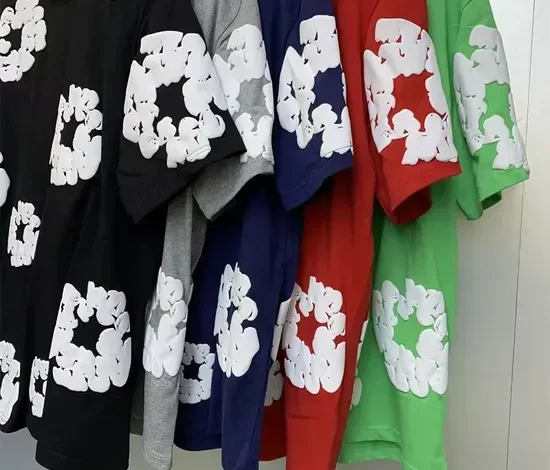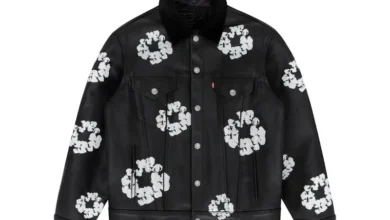Denim Tears A Cultural Revolution Through Denim Design

Denim Tears was founded by Tremaine Emory as a brand that transcends fashion, becoming a cultural statement that reclaims Black identity through the language of design. Born from a deep understanding of history and art, the brand reimagines Denim Tears as a tool of resistance and remembrance. Emory’s vision connects the past with the present, using clothing as a narrative of survival, pride, and creativity. Each piece tells a story of struggle and strength, transforming everyday garments into symbols of liberation, reminding the world that fashion can be both beautiful and revolutionary.
The Message Woven in Every Thread
Every stitch in Denim Tears carries meaning beyond style—it’s a declaration of history and heritage. The cotton used in the brand’s signature pieces symbolizes the painful legacy of slavery, turning a material of oppression into one of empowerment. Through powerful imagery, embroidery, and symbolism, Emory ensures that the wearer becomes part of a larger dialogue about identity and justice. Denim Tears invites reflection and awareness, transforming garments into living archives of the Black experience, proving that fashion can educate as deeply as it inspires and adorns.
Tremaine Emory: The Visionary Behind the Movement
Tremaine Emory, the creative force behind Denim Tears, blends activism and artistry with unmatched authenticity. Known for his collaborations with brands like Levi’s, Converse, and Supreme, Emory uses his platform to spotlight stories often erased from mainstream fashion. His approach intertwines storytelling with craftsmanship, ensuring that each collection resonates on emotional and cultural levels. Emory’s work challenges the fashion industry to recognize the power of representation, creating garments that don’t just look good but speak truth. His leadership has redefined what it means to design with purpose and cultural consciousness.
Denim as a Canvas for Cultural Expression
For Denim Tears, denim is more than fabric—it’s a canvas where culture and consciousness meet. Denim’s history as a durable, working-class material mirrors the endurance of Black culture throughout centuries of struggle and triumph. Emory elevates this humble textile into a medium of protest and pride. Through patterns, prints, and symbolic motifs, he transforms jeans and jackets into visual essays about race, history, and resilience. Denim Tears uses everyday wear to spark dialogue and bridge generations, proving that clothing can be a tool of education and collective empowerment.
The Role of History in Denim Tears Collections
Every Denim Tears collection is rooted in historical context, paying homage to the enslaved African Americans who cultivated the cotton that shaped the nation’s economy. Emory draws direct connections between fashion and history, ensuring that consumers confront the uncomfortable truths embedded within the fabric they wear. His designs often reference African and African American art, literature, and cultural resistance. By reclaiming narratives erased by colonialism and capitalism, Denim Tears reminds the world that history must not be forgotten—it must be worn with pride, acknowledgment, and purpose.
Collaborations that Redefine Fashion Activism
Denim Tears has collaborated with iconic brands like Levi’s and Converse, turning commercial partnerships into opportunities for storytelling. Each collaboration infuses mainstream fashion with messages of racial awareness and historical reflection. By merging his designs with globally recognized brands, Emory ensures that his message reaches wider audiences. These projects go beyond aesthetics—they challenge consumers to question the origins of what they wear. Through strategic collaborations, Denim Tears transforms the fashion industry into a space for activism, inspiring others to create with meaning and conscience rather than trend and profit.
The Intersection of Art, Music, and Fashion
Denim Tears thrives at the crossroads of art, music, and fashion—three powerful forces that shape modern culture. Emory often draws inspiration from Black musicians, poets, and artists who used creativity as resistance. From gospel and blues to hip-hop and jazz, the sounds of Black America echo through Denim Tears’ visual language. Each design reflects rhythm, rebellion, and resilience. By fusing artistic mediums, Emory creates garments that are both wearable art and cultural commentary, reminding the world that fashion can amplify voices and preserve stories that history tried to silence.
Fashion as a Tool for Social Change
Denim Tears redefines fashion as activism, using clothing to challenge systemic inequality and promote awareness. Emory’s collections confront colonial legacies, racial injustice, and consumer ignorance, pushing wearers to think critically about the stories behind their clothes. His work proves that fashion isn’t superficial—it’s deeply political. Each design becomes a conversation starter, an educational platform, and a protest in fabric form. By merging beauty with purpose, Denim Tears empowers a new generation to use creativity as resistance, proving that true style is not just seen—it’s felt and understood.
The Global Impact of Denim Tears
What began as a personal project has evolved into a global movement inspiring dialogue across cultures. Denim Tears resonates far beyond the United States, influencing designers, activists, and educators worldwide. Its message of reclaiming identity and confronting history appeals universally, reminding humanity of the shared struggles for equality and dignity. Through exhibitions, collaborations, and storytelling, Emory’s brand has reached museums, fashion weeks, and classrooms alike. Denim Tears demonstrates that clothing can transcend borders and become a universal language of empathy, truth, and collective empowerment.
The Legacy of Denim Tears in Modern Culture
Denim Tears stands as a testament to fashion’s transformative potential. It’s not merely a brand—it’s a cultural revolution stitched in denim. Tremaine Emory has shown that design can rewrite narratives, Denim Tears Tracksuit honor ancestors, and empower future generations. The legacy of Denim Tears lies in its ability to merge artistry with activism, turning pain into power and fabric into freedom. As the movement grows, it continues to challenge the industry to create consciously and dress with intention. Denim Tears proves that fashion’s greatest power lies in its ability to tell stories that change the world.



